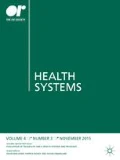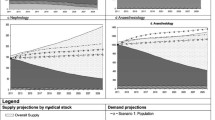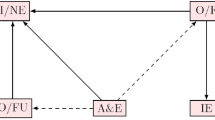Abstract
Each year Emilia-Romagna health managers have to negotiate the number of medical specialization grants to be financed by the National government and define the number of additional grants to be funded by the regional budget. The final goal of this study is to provide a Decision Support System for grant allocation to medical specializations within Emilia-Romagna over a 20-year planning horizon. We have developed a System Dynamics (SD) model that represents regional medical specialist human resources and forecasts population needs over the planning horizon. The SD model provides a requirement indicator for each medical specialization. On the basis of these indicators, an Integer Programming model computes optimal assignments of medical specialization grants. We then define three demand scenarios and show how regional and national funded grants can be managed in order to reduce future gaps by comparing our results with current policies.







Similar content being viewed by others
References
Barber P and Lopez-Valcarcel B (2010) Forecasting the need for medical specialists in Spain: application of a system dynamics model. Human Resources for Health 8(1), 24.
Barlas Y (1989) Multiple tests for validation of system dynamics type of simulation models. European Journal of Operational Research 42(1), 59–87.
Birch S, O’Brien-Pallas L, Alksnis C, Tomblin Murphy G and Thomson D (2003) Beyond demographic change in human resources planning: an extended framework and application to nursing. Journal of Health Services Research and Policy 8(4), 225–229.
Birch S, Kephart G, Tomblin Murphy G, O’Brien-Pallas L, Alder R and MacKenzie A (2007) Human resources planning and the production of health: a needs-based analytical framework. Canadian Public Policy 2007 XXXIII(Suppl 1), S1–S16.
Center for Workforce Intelligence (CfWI) (2015) CfWI technical paper series. [WWW document] http://www.cfwi.org.uk/our-work/research-development/cfwi-technical-paper-series (accessed 1 March 2015).
Coste E and Doan BD (2003) Forecast of physician workforce in the 22 French regions (1998–2013). Cahiers de sociologie et de démographie médicales 43(1), 5–70.
Decreto-49 (2012) Linee di indirizzo regionali in materia di determinazione delle dotazioni organiche delle Aziende USL. Decreto del Commissario ad acta n. 49 dell’8 ottobre 2012.
Doan B (2004) Aging of population and medical workforce: a prospective view of health care provision in France in the year 2025. Cahiers de sociologie et de démographie médicales 44(2), 243–266.
ER-Statistica (2012) Previsioni demografiche in Emilia-Romagna. [WWW document] http://statistica.regione.emilia-romagna.it/factbook/popolazione/previsioni-demografiche (accessed 1 February 2014).
European Union (EU)-Commission (2008) Green paper on the European workforce for health. Commission of the European Communities, Brussels.
EUHWForce (2014) EU. Joint action health workforce planning and forecasting. [WWW document] http://www.euhwforce.eu/ (accessed 1 February 2014).
Forrester J and Senge P (1980) Tests for building confidence in system dynamics models. TIMS Studies in the Management Science 14, 209–228.
Greenberg L and Cultice JM (1997) Forecasting the need for physicians in the United States: the health resources and services administration’s physician requirements model. Health Services Research 31(6), 723–737.
Hall T (2001) Human resources for health: models for projecting workforce supply and requirements. [WWW document] http://www.who.int/hrh/tools/models.pdf (accessed 4 June 2015).
Hedden L, Barer ML, Cardiff K, McGrail KM, Law MR and Bourgeault IL (2014) The implications of the feminization of the primary care physician workforce on service supply: a systematic review. Human Resources for Health 12, 32.
HHS (2005) Physician workforce policy guidelines for the United States, 2000–2020. U.S. Department of Health & Human Services, Rockville, Maryland.
Joyce C, McNeil J and Stoelwinder J (2006) More doctors, but not enough: Australian medical workforce supply 2001–2012. The Medical Journal of Australia 184(9), 441–446.
Joyce C and McNeil J (2006) Participation in the workforce by Australian medical graduates. Medical Education 40(4), 333–339.
Kalbfleisch JD and Prentice RL (2011) The Statistical Analysis of Failure Time Data, Vol 360, John Wiley & Sons, Hoboken, NJ.
Lodi A, Tubertini P, Grilli R, Mazzochetti A, Ruozi C and Senese F (2014a) Risorse umane in sanità per una previsione dei fabbisogni in Emilia-Romagna, [WWW document] http://assr.regione.emilia-romagna.it/it/servizi/pubblicazioni/dossier/doss239-abs (accessed 1 August 2014).
Lodi A, Tubertini P, Grilli R, Mazzochetti A, Ruozi C and Senese F (2014b) Needs forecast and fund allocation of medical specialty positions in emilia-romagna (Italy) by system dynamics and integer programming: Simulation results. [WWW document] http://www.or.deis.unibo.it/tubertini/HHRforecastingsimulationresults.pdf (accessed 1 April 2015).
Nicholson S and Propper C (2011) Chapter fourteen – Medical workforce. In Handbook of Health Economics (Pauly MV, Mcguire TG and Barros PP, Eds), Vol 2 pp 873–925, Elsevier, Amsterdam.
Nooney JG and Lacey LM (2007) Validating Hrsa’s nurse supply and demand models: a state-level perspective. Nursing Economics 25(5), 270–278.
O’Brien-Pallas L, Baumann A, Donner G, Tomblin Murphy G, Lochhaas-Gerlach J and Luba M (2001) Forecasting models for human resources in health care. Journal of Advanced Nursing 33(1), 120–129.
O’Brien-Pallas L, Tomblin Murphy G, Birch S, Kephart G, Meyer R, Eisler K, Lethbridge L and Cook A (2007) Health human resources modelling: Challenging the past, creating the future. [WWW document] http://www.cfhi-fcass.ca/Migrated/PDF/ResearchReports/OGC/OBrien-1_3_25.pdf (accessed 4 June 2015).
Ono T, Lafortune G and Schoenstein M (2013) Health workforce planning in OECD countries. OECD Health Working Papers, OECD, Paris, France.
Persaud D and Narine L (1999) Cross-national comparison of capitation funding: the American, British and Dutch experience. Health Services Management Research : An Official Journal of the Association of University Programs in Health Administration/HSMC, AUPHA 12(2), 121–135.
Qudrat-Ullah H and Seo Seong B (2010) How to do structural validity of a system dynamics type simulation model: The case of an energy policy model. Energy Policy 38(5), 2216–2224 Greater China Energy: Special Section with regular papers.
RI (2012) Disposizioni urgenti per la revisione della spesa pubblica con invarianza dei servizi ai cittadini. Legge, 06/07/2012 n¡ 94, G.U. 06/07/2012. [WWW document] http://www.gazzettaufficiale.it/eli/id/2012/07/06/012G0117/sg (accessed 1 March 2015).
Roberfroid D, Leonard C and Stordeur S (2009) Physician supply forecast: better than peering in a crystal ball? Human Resources for Health 7(1), 1–13.
Schofield D (2007) Replacing the projected retiring baby boomer nursing cohort 2001–2026. BMC Health Services Research 7(1), 87.
Tomblin Murphy G, Kephart G, Lethbridge L, O’Brien-Pallas L and Birch S (2009) Planning for what? Challenging the assumptions of health human resources planning. Health Policy 92(2–3), 225–233.
Van Greuningen M, Batenburg R and Van der Velden L (2012) Ten years of health workforce planning in the netherlands: a tentative evaluation of gp planning as an example. Human Resources for Health 10(1), 21.
World Health Organization (WHO) (2010) Models and Tools for Health Workforce Planning and Projections. World Health Organization, Geneva.
Author information
Authors and Affiliations
Corresponding author
Appendices
Appendix A
Simulation detailed outputs
Surgical area
Medical area
Diagnostic and clinical services area
Appendix B
Detailed allocation results
Appendix C
Graphs forecast legend

Appendix D
Surgical area forecasts
Appendix E
Medical area forecasts
Appendix F
Diagnostic and clinical services area forecasts
Rights and permissions
About this article
Cite this article
Lodi, A., Tubertini, P., Grilli, R. et al. Needs forecast and fund allocation of medical specialty positions in Emilia-Romagna (Italy) by system dynamics and integer programming. Health Syst 5, 213–236 (2016). https://doi.org/10.1057/hs.2015.11
Published:
Issue Date:
DOI: https://doi.org/10.1057/hs.2015.11







